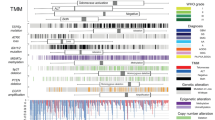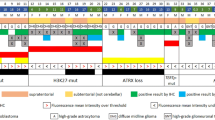Abstract
Human malignant gliomas exhibit acquisition of either one of two telomere maintenance mechanisms, resulting from either reactivation of telomerase expression or activation of an alternative lengthening of telomeres (ALT) mechanism. In the present study, we analyzed 63 human malignant gliomas for the presence of ALT-specific extrachromosomal circles of telomeric DNA (C-circles) and measured telomerase expression, telomeric DNA content (Telo/Alu method), and telomeric repeat-containing RNAs (TERRA) levels. We also assessed histomolecular markers routinely used in clinical practice. The presence of C-circles significantly correlated with IDH1/2 mutation, MGMT exon 1 methylation, low Ki-67 immunostaining, increased telomeric DNA content, absence of functional ATRX protein and level of HTERT gene expression. In multivariate analysis, we observed a trend to a correlation between elevated TERRA levels and increased survival. Interestingly, the C-circles assay allowed to detect ALT activation in glioblastomas exhibiting wild-type IDH1/2 and ATRX expression. These results suggest that, after the correlations uncovered here have been confirmed on larger numbers of tumors, telomeric markers might be useful in improving diagnosis. They also point out to the utility of using the specific, sensitive and quantitative C-circle and Telo/Alu assays that can work with as few as 30 ng of tumor DNA.


Similar content being viewed by others
References
Artandi SE, DePinho RA (2010) Telomeres and telomerase in cancer. Carcinogenesis 31:9–18
Bryan TM, Englezou A, Dalla-Pozza L et al (1997) Evidence for an alternative mechanism for maintaining telomere length in human tumors and tumor-derived cell lines. Nat Med 3:1271–1274
Pickett HA, Reddel RR (2015) Molecular mechanisms of activity and derepression of alternative lengthening of telomeres. Nat Struct Mol Biol 22:875–880
Durant ST (2012) Telomerase-independent paths to immortality in predictable cancer sub-types. J Cancer 3:67–82
Henson JD, Hannay JA, SmcCarthy SW et al (2005) A robust assay for alternative lengthening of telomeres in tumors shows the significance of alternative lengthening of telomeres in sarcomas and astrocytomas. Clin Cancer Res 11:217–225
Hakin-Smith V, Jellinek DA, Levy D et al (2003) Alternative lengthening of telomeres and survival in patients with glioblastoma multiforme. The Lancet 361:836–838
McDonald KL, McDonnell J, Muntoni A et al (2010) Presence of alternative lengthening of telomeres mechanism in patients with glioblastoma identifies a less aggressive tumor type with longer survival. J Neuropathol Exp Neurol 69:729–736
Heaphy CM, de Wilde RF, Jiao Y et al (2011) Altered telomeres in tumors with ATRX and DAXX mutations. Science 1333:425
Bérubé NG (2011) ATRX in chromatin assembly and genomearchitecture during development and disease. Biochem Cell Biol 89:435–444
Henson JD, Cao Y, Huschtscha LI et al (2009) DNA C-circles are specific and quantifiable markers of alternative-lengthening-of-telomeres activity. Nat Biotechnol 27:1181–1186
Louis DN, Ohgaki H, Wiestler OD et al (2007) The 2007 WHO classification of tumours of the central nervous system. Acta Neuropathol 114:97–109
Fogli A, Chautard E, Vaurs-Barrière C et al (2016) The tumoral A genotype of the MGMT rs34180180 single-nucleotide polymorphism in aggressive gliomas is associated with shorter patients’ survival. Carcinogenesis 37:169–176
Karayan-Tapon L, Quillien V, Guilhot J et al (2010) Prognostic value of O6-methylguanine-DNA methyltransferase status in glioblastoma patients, assessed by five different methods. J Neurooncol 97:311–322
Quillien V, Lavenu A, Karayan-Tapon L et al (2012) Comparative assessment of 5 methods (methylation-specific polymerase chain reaction, MethyLight, pyrosequencing, methylation-sensitive high-resolution melting, and immunohistochemistry) to analyze O6-methylguanine-DNA-methyltranferase in a series of 100 glioblastoma patients. Cancer 118:4201–4211
Ducray F, Crinière E, Idbaih A et al (2009) Alpha-internexin expression identifies 1p19q codeleted gliomas. Neurology 72:156–161
Ducray F, Mokhtari K, Crinière E et al (2011) Diagnostic and prognostic value of alpha internexin expression in a series of 409 gliomas. Eur J Cancer 47:802–808
Yeager T, Neumann A, Englezou A et al (1999) Telomerase-negative immortalized human cells contain a novel type of promyelocytic leukemia (PML) body. Cancer Res 59:4175–4179
Kreth S, Heyn J, Grau S et al (2010) Identification of valid endogenous control genes for determining gene expression in human glioma. Neuro-Oncol 12:570–579
Livak KJ, Schmittgen TD (2001) Analysis of relative gene expression data using real-time quantitative PCR and the 2(-Delta Delta C(T)) method. Methods 25:402–408
Sampl S, Pramhas S, Stern C et al (2012) Expression of telomeres in astrocytoma WHO grade 2 t0 4: TERRA level correlates with telomere length, telomerase activity, and advanced clinical grade. Transl Oncol 5:56–65
Broccoli D, Godley LA, Donehower LA et al (1996) Telomerase activation in mouse mammary tumours: lack of telomere shortening and evidence for regulation of telomerase with RNA cell proliferation. Mol Cell Biol 16:3765–3772
Aubert G, Hills M, Lansdorp PM (2012) Telomere length measurement—caveats and a critical assessment of the available technologies and tools. Mut Res 730:59–67
Louis DN, Perry A, Reifenberger G et al (2016) The 2016 World Health Organization classification of tumors of the central nervous system: a summary. Acta Neuropathol 131:803–820
Killela PJ, Reitman ZJ, Jiao Y et al (2013) TERT promoter mutations occur frequently in gliomas and a subset of tumors derived from cells with low rates of self-renewal. Proc Natl Acad Sci USA 110:6021–6026
Azzalin CM, Reichenbach P, Khoriauli L et al (2007) Telomeric repeat containing RNA and RNA surveillance factors at mammalian chromosome ends. Science 318:798–801
Azzalin CM, Lingner J (2014) Telomere functions grounding on TERRA firma. Trends Cell Biol 25:29–36
Heaphy CM, de Wilde RF, Jiao Y et al (2011) Altered telomeres in tumors with ATRX and DAXX mutations. Science 333:425
Bower K, Napier CE, Cole SL et al (2012) Loss of wild-type ATRX expression in somatic cell hybrids segregates with activation of alternative lengthening of telomeres. PLoS ONE 7:e50062
Royds JA, Al Nadaf S, Wiles AK et al (2011) The CDKN2A G500 allele is more frequent in GBM patients with no defined telomere maintenance mechanism tumors and is associated with poorer survival. PLoS ONE 6:e26737
Jiao Y, Killela PJ, Reitman ZJ et al (2012) Frequent ATRX, CIC, FUBP1 and IDH1 mutations refine the classification of malignant gliomas. Oncotarget 3:709–722
Heaphy CM, Subhawong AP, Hong SM et al (2011) Prevalence of the alternative lengthening of telomeres telomere maintenance mechanism in human cancer subtypes. Am J Pathol 179:1608–1615
Yan W, Zhang W, You G et al (2012) Correlation of IDH1 mutation with clinicopathologic factors and prognosis in primary glioblastoma: a report of 118 patients from China. PLoS ONE 7:e30339
Leu S, von Felten S, Frank S et al (2013) IDH/MGMT-driven molecular classification of low-grade glioma is a strong predictor for long-term survival. Neuro-Oncol 15:469–479
Ferrandon S, Saultier P, Carras J et al (2013) Telomere profiling: toward glioblastoma personalized medicine. Mol Neurobiol 47:64–76
Flynn RL, Cox KE, Jeitany M et al (2015) Alternative lengthening of telomeres renders cancer cells hypersensitive to ATR inhibitors. Science 347:273–277
Acknowledgements
We thank Mélanie Müller-Barthélémy and Annette Quinsat for technical assistance, Valérie Gouilleux for the gift of cell lines, as well as the “Département Génomique PPF ASB” facility at University François-Rabelais of Tours for access to the Storm phosphorimager. This work was supported by grants from the “Fondation de France” and from the “Ligue Grand-Ouest contre le Cancer, comités Eure-et-Loir, Ille-et-Vilaine, Indre-et-Loire, Morbihan, Vendée, Vienne” (MC lab) as well as from The French National Research Agency (ANR: project BIVANDEV), the “Ligue contre le Cancer, comités du Puy-de-Dôme et Ardèche”, the “Fondation ARC”, and the “Conseil régional d’Auvergne” (PA lab), and the Plan Cancer-INSERM (CS14085CS “Gliobiv”) (PV and PA labs).
Author information
Authors and Affiliations
Corresponding author
Ethics declarations
Conflict of interest
All authors declare that they have no conflict of interest.
Additional information
Michel Charbonneau and Pierre Verrelle are co-senior authors.
Electronic supplementary material
Below is the link to the electronic supplementary material.
Rights and permissions
About this article
Cite this article
Fogli, A., Demattei, MV., Corset, L. et al. Detection of the alternative lengthening of telomeres pathway in malignant gliomas for improved molecular diagnosis. J Neurooncol 135, 381–390 (2017). https://doi.org/10.1007/s11060-017-2585-7
Received:
Accepted:
Published:
Issue Date:
DOI: https://doi.org/10.1007/s11060-017-2585-7




